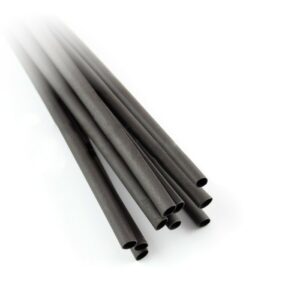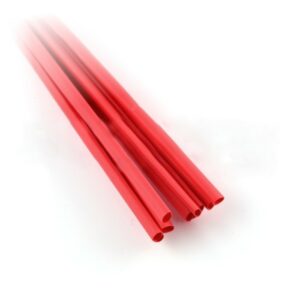Table of Contents:
Wondering how to protect cables and wires in extreme conditions? Meet the shrink wrap – a reliable solution used in many industries. By reading this article, you will learn how to use its potential in your projects. Discover the benefits of using a shrink wrap today!
Shrink wrap - basic information
Heat shrinkable cable tie
is an extremely effective and indispensable tool that has gained popularity in many fields, such as electronics, automotive and construction. Created from a heat-shrinkable polymer, the shrink wrap exhibits unique properties that allow it to shrink when heated to a specific, predetermined size.
The use of shrink-wrap covers a wide range of applications. Below are some of them:
- In electronics – as insulation for exposed electrical wires, while providing protection from moisture and dirt;
- In the automotive industry – it is used to protect electrical connections in motor vehicles, protecting them from corrosion;
- In construction – water and dust can harm the wires. The shrink wrap protects the cables from such damage.
The shrink wrap is not only practical, but also easy to use, making it an excellent choice for professionals and amateurs.
Construction and operation of the shrink wrap
Construction
of the shrink wrap
is simple, yet ingenious. The band is formed from a heat-shrinkable polymer, a substance that responds to heating by shrinking. It is this specific design that is the key to the exceptional performance of this unique band. Nevertheless, the choice of the right type of polymer is fundamental to the final properties of the band, such as shrinking temperature, degree of shrinkage and wall thickness.
The basic process that results from the construction of a heat shrink band is its operation when heated. When heat is applied to the band – for example, with a hair dryer, heater or soldering iron – the polymer begins to shrink, conforming to the shape of the object to which it is applied.
The degree of shrinkage depends on the type of band. Most importantly, however, this process is irreversible – after cooling down, the shrink wrap retains its current shape, providing secure, durable and reliable protection for cables, even in the most extreme conditions. This is definitely one of the most important uses of this amazing wristband.
Applications of shrink-wrap in practice
Heat shrinkable cable tie
, due to its insulating and protective capabilities, has been used in many different fields. In telecommunications, they are used to protect optoelectronic fibers and cables from damage caused by moisture or mechanical trauma. In the energy sector, heat shrink ties protect reported cable and spur terminations from fading and corrosion.
However, the use of shrink-wrap does not end with professional applications. DIYers have also noticed its practical value. Shrink-wrap can play a key role in the creation of home electronic projects, improving their reliability and durability. It can also be used to repair damaged wires in home appliances, from extension cords to headphone cables.
Generally speaking, its ability to effectively secure and insulate cables in extreme conditions makes a heat shrink cable tie a tool worth having in your arsenal of tools, whether you are a professional or a hobbyist.
Instructions for installing the heat shrink wrap
The first step to properly installing
heat shrinkable cable tie
is to take the correct measurement of the cable to be secured. You need to know its width and length. Remember that at each end the band should extend about 1-2 cm beyond the wire to ensure effective insulation.
The next step is to choose the correct diameter of the heat shrink band. Remember that it should be about 20-30% larger than the diameter of the wire to allow it to slide freely onto the wire before shrinking. Once you have chosen the right cable tie, cut off the length of heat shrink cable tie needed to secure the cable.
Then place the cable tie on the cable. Warm up the band, for example with a hair dryer set to heat, but direct application of the flame should be avoided so as not to damage the band. Warm up the band evenly to allow even contraction. During this process, the shrink wrap begins to shrink, adjusting to the shape and size of the cable. Above all, remember to be careful and do not expose your hands to direct heat.
After adequate heating, let the band cool. Do not try to speed up the process, for example, by cooling in water, as this may affect the insulating properties of the band. Once cooled, the band retains its shape and is ready for use. If the band is still loose after cooling, the warming process can be repeated.
Benefits of using heat shrink sleeves
Use of
heat shrinkable cable tie
carries a number of benefits that make this solution very popular. First of all, thanks to its unique design, the band, when heated, adheres perfectly to the surface of the cable or wire, creating a durable and effective insulation. This ensures not only that the cables are protected from aging, corrosion or adverse external factors, but also increases the safety of equipment use.
Comparing with other available solutions, the shrink wrap stands out for its ease of use. The process of securing the cable is intuitive and requires no specialized equipment, only a heat source. What’s more, the shrink wrap is a reusable product – if necessary, you can always remove it and put on a new one. This feature makes heat shrink ties a cost-effective solution that minimizes the cost of maintaining, repairing or replacing damaged cables.
Taking into account all these benefits, there is no doubt that the use of heat shrink ties is an excellent investment for both professionals and individuals who are looking for reliable and effective solutions to secure their cables and wires.
How useful was this post?
Click on a star to rate it!
Average rating 0 / 5. Vote count: 0
No votes so far! Be the first to rate this post.





















